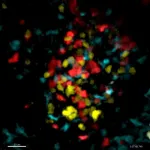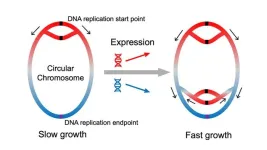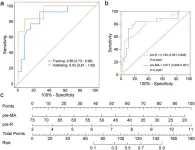(Press-News.org) Researchers had been studying the green alga Chlamydomonas reinhardtii for decades without seeing evidence of an active virus within it — until a pair of Virginia Tech researchers waded into the conversation.
Maria Paula Erazo-Garcia and Frank Aylward not only found a virus in the alga but discovered the largest one ever recorded with a latent infection cycle, meaning it goes dormant in the host before being reactivated to cause disease.
“We’ve known about latent infections for a long time,” said Aylward, associate professor in the Department of Biological Sciences. “A lot of viruses are temperate in the sense that they can integrate their genomes in that of the host and sometimes lay dormant for long periods of time, but what’s remarkable about this virus is that it’s so large. This is the largest temperate virus discovered to date with this particular infection cycle.”
Erazo-Garcia, a Ph. D. candidate and member of the Aylward Lab, was the lead author of the paper detailing the findings, which was published in Science.
The researchers leveraged international collaborations and campus resources in both the Fralin Life Science Institute’s Genomics Sequencing Center and the Virginia Tech’s Nanoscale Characterization and Fabrication Laboratory to unearth the virus, which they named Punuivirus.
They demonstrated that when integrated into a host’s genome, it can reactivate and spontaneously produce viral particles that are released in healthy cell cultures.
Along with the novel findings, the researchers believe the study also will shed light on potential biotechnological applications, especially those involved in the delivery and integration of DNA. This could potentially be exploited for gene editing applications.
“It’s fascinating to think that all these things we’re trying to engineer in other systems are already happening naturally here,” Aylward said. “It’s a wonderful opportunity to learn how viral enzymes initiate DNA integration because they can be co-opted for biotechnological purposes.”
According to Aylward, Chlamydomonas reinhardtii is one of the most well-studied green algae. Scientists have information dating back to the 1970s that indicates viral production in otherwise healthy cultures of some green algae. They suspected it could be from the activity of latent viruses, but this was difficult to prove because of technological limitations and the possibility of environmental contamination.
Typically, if a healthy alga with a full green, dense culture is infected, the cells will die rapidly and there will be visual evidence. The cells will often group together, and the green flask will quickly turn clear.
“[Originally,] we weren’t seeing this at all,” Aylward said. “The culture looked completely healthy. You wouldn’t know that there was any viral infection unless you did these sophisticated molecular analyses.”
To check for viral elements in the alga, researchers conducted long read sequencing, a process that analyzes long strands of DNA, to test a particular alga strain known for containing viral elements. This work was conducted in the Genomics Sequencing Center with additional guidance from the Max Planck Institute for Biology Tübingen.
They then assessed whether the viral element was active and could produce viral particles by monitoring the parent virus’s production in cultures from inoculation to stationary phase and found a distinct population of viral particles.
“We needed evidence that it was there,” said Erazo-Garcia, who is studying biological sciences. “And getting images is one of the most convincing ways to convince the community that this is an active virus.”
The cultures showed that parent viruses were produced at late exponential and early stationary phases of host growth and that only a small number of cells contained active viruses, which is why the infection was difficult to detect.
Further investigation at Virginia Tech’s Nanoscale Characterization and Fabrication Laboratory showed that viral particles were present in the cultures, again demonstrating latent infection.
Collaboration was key, as Aylward and Garcia also worked with researchers at the University of Lund in Sweden and the Royal Institute of Sea Research in the Netherlands, comparing findings that indicated similar infection dynamics, and at the University of Miami, where a collaborator helped lay groundwork that led to the discovery.
Additional authors include:
Uri Sheyn, research scientist in the Department of Biological Sciences
Zachary Barth, postdoctoral associate in the Department of Biological Sciences
Abdeali Jivaji, Ph.D. candidate in the Department of Biological Sciences
Keith Ray, senior research associate in the Department of Biochemistry
Rory Craig, Department of Algal Development and Evolution, postdoctoral fellow at the Max Planck Institute for Biology Tübingen
Corina Brussaard, Royal Institute of Sea Research, the Netherlands
Charlie Cornwallis, professor in the Department of Biology, Lund University
Karin Rengefors, researcher in the Department of Biology, Lund University
Maria Svensson-Coelho, Department of Biology, Lund University
Petronella Wessman, research engineer in the Department of Biology, Lund University
Mohammad Moniruzzaman, assistant professor in the Department of Marine Biology and Ecology, University of Miami END
Researchers discover large dormant virus can be reactivated in model green alga
Frank Aylward and Maria Paula Erazo Garcia’s findings suggest the prevalence of large viruses and latent infection cycles in the model green alga Chlamydomonas reinhardtii
2025-04-10
ELSE PRESS RELEASES FROM THIS DATE:
New phase of the immune response uncovered
2025-04-10
The research groups led by Wolfgang Kastenmüller and Georg Gasteiger employed innovative microscopy techniques to observe how specific immune cells, known as T-cells, are activated and proliferate during a viral infection. Their findings revealed novel mechanisms: the immune system amplifies its defense cells in a far more targeted way than previously believed.
T-Cells Proliferate and Specialize During the Immune Response
T-cells are crucial defense cells in the immune system. To effectively ...
Drawing board rather than salt shaker
2025-04-10
Bioinformaticians from Heinrich Heine University Düsseldorf (HHU) and the university in Linköping (Sweden) have established that the genes in bacterial genomes are arranged in a meaningful order. In the renowned scientific journal Science, they describe that the genes are arranged by function: If they become increasingly important at faster growth, they are located near the origin of DNA replication. Accordingly, their position influences how their activity changes with the growth rate.
Are genes distributed randomly along the bacterial chromosome, as if scattered from a salt shaker? This opinion, which is held by a majority of researchers, has ...
Engineering invites submissions on AI for engineering
2025-04-10
Artificial intelligence (AI) is playing an increasingly pivotal role in revolutionizing the field of engineering, triggering a new era of technological and industrial evolution. A series of recent breakthroughs in areas like natural language processing, computer vision, and machine learning, with the Nobel Prize-winning work in artificial neural networks and protein structure prediction serving as prime examples, have effectively bridged the gap between the physical and digital worlds. The emergence of general AI technologies, especially large language models, has given rise ...
In Croatia’s freshwater lakes, selfish bacteria hoard nutrients
2025-04-10
Bacteria play key roles in degrading organic matter, both in the soil and in aquatic ecosystems. While most bacteria digest large molecules externally, allowing other community members to share and scavenge, some bacteria selfishly take up entire molecules before digesting them internally. In a paper publishing April 10 in the Cell Press journal Cell Reports, researchers document “selfish polysaccharide uptake” in freshwater ecosystems for the first time. In Croatia’s Kozjak and Crniševo Lakes, they found that nutrient hoarding allows selfish species ...
Research suggests our closest neighboring galaxy may be being torn apart
2025-04-10
A team led by Satoya Nakano and Kengo Tachihara at Nagoya University in Japan has revealed new insights into the motion of massive stars in the Small Magellanic Cloud (SMC), a small galaxy neighboring the Milky Way. Their findings suggest that the gravitational pull of the Large Magellanic Cloud (LMC), the SMC’s larger companion, may be tearing the smaller one apart. This discovery reveals a new pattern in the motion of these stars that could transform our understanding of galaxy evolution and interactions. The results were published ...
Researchers identify factors in early-life linked to body fat in South Asian children
2025-04-10
Researchers at McMaster University have identified six key factors in the first three years of life that influence the trajectory of obesity in South Asian children.
The findings offer parents, primary care practitioners and policymakers new insights into addressing childhood obesity for a group of children who have a higher prevalence of abdominal fat and cardiometabolic risk factors, as well as a predisposition to diabetes.
“We know that current measures of childhood obesity such as the body mass index (BMI) don’t work well for South Asians because of the so called ‘thin-fat’ phenotype: South Asian newborns are characterized as low birth weight, but proportionally ...
Environment: Less than 10% of global plastics manufactured from recycled materials
2025-04-10
Only 9.5% of plastic materials produced globally in 2022 were manufactured from recycled materials. The findings, reported in Communications Earth & Environment, are part of a comprehensive analysis of the global plastics sector, which also reveals a large increase in the amount of plastic being disposed of by incineration and substantial regional differences in plastic consumption.
Plastic production has increased from two million tonnes per year in 1950 to 400 million tonnes per year in 2022 and ...
Influenza vaccination among people with Medicare by race and ethnicity, education, and rurality
2025-04-10
About The Study: In this cross-sectional survey study, although overall influenza vaccination rates changed little from 2019 to 2022, they increased substantially for Black and Hispanic older adults, particularly those in rural areas, and decreased for some groups of white older adults. Determining the reasons for these divergent changes in influenza vaccination rates is a high priority for future research.
Corresponding Author: To contact the corresponding author, Marc N. Elliott, PhD, email elliott@rand.org.
To access the embargoed study: Visit our For The Media website at this link https://media.jamanetwork.com/
(doi:10.1001/jamanetworkopen.2025.4462)
Editor’s ...
Neighborhood characteristics and mental health from childhood to adolescence
2025-04-10
About The Study: In this cohort study of children and adolescents, associations between neighborhood characteristics and mental health evolved from childhood through adolescence. These findings suggest that targeted interventions in disadvantaged neighborhoods and strategies to protect young children from air pollution are essential. A comprehensive approach is recommended to incorporate air pollution, green space, and socioeconomic status not only in residential neighborhoods but also in other settings, such as schools.
Corresponding Author: To contact the ...
Centrifugation liver support using regional mesylate anticoagulation is safe for liver failure patients with high risk of bleeding
2025-04-10
Background and objectives
Patients with acute liver failure (ALF) or acute-on-chronic liver failure (ACLF) are at high risk of bleeding with traditional artificial liver support systems. To address the bleeding risk in liver failure patients, the safety of regional mesylate anticoagulation (RMA) in centrifugation artificial liver support systems (cALSS) is proposed for study.
Methods
In this prospective single-arm study, ALF and ACLF patients were treated with cALSS using RMA. Coagulation function was monitored, and the predictors of mesylate dose were analyzed ...
LAST 30 PRESS RELEASES:
Making lighter work of calculating fluid and heat flow
Normalizing blood sugar can halve heart attack risk
Lowering blood sugar cuts heart attack risk in people with prediabetes
Study links genetic variants to risk of blinding eye disease in premature infants
Non-opioid ‘pain sponge’ therapy halts cartilage degeneration and relieves chronic pain
AI can pick up cultural values by mimicking how kids learn
China’s ecological redlines offer fast track to 30 x 30 global conservation goal
Invisible indoor threats: emerging household contaminants and their growing risks to human health
Adding antibody treatment to chemo boosts outcomes for children with rare cancer
Germline pathogenic variants among women without a history of breast cancer
Tanning beds triple melanoma risk, potentially causing broad DNA damage
Unique bond identified as key to viral infection speed
Indoor tanning makes youthful skin much older on a genetic level
Mouse model sheds new light on the causes and potential solutions to human GI problems linked to muscular dystrophy
The Journal of Nuclear Medicine ahead-of-print tip sheet: December 12, 2025
Smarter tools for peering into the microscopic world
Applications open for funding to conduct research in the Kinsey Institute archives
Global measure underestimates the severity of food insecurity
Child survivors of critical illness are missing out on timely follow up care
Risk-based vs annual breast cancer screening / the WISDOM randomized clinical trial
University of Toronto launches Electric Vehicle Innovation Ontario to accelerate advanced EV technologies and build Canada’s innovation advantage
Early relapse predicts poor outcomes in aggressive blood cancer
American College of Lifestyle Medicine applauds two CMS models aligned with lifestyle medicine practice and reimbursement
Clinical trial finds cannabis use not a barrier to quitting nicotine vaping
Supplemental nutrition assistance program policies and food insecurity
Switching immune cells to “night mode” could limit damage after a heart attack, study suggests
URI-based Global RIghts Project report spotlights continued troubling trends in worldwide inhumane treatment
Neutrophils are less aggressive at night, explaining why nighttime heart attacks cause less damage than daytime events
Menopausal hormone therapy may not pose breast cancer risk for women with BRCA mutations
Mobile health tool may improve quality of life for adolescent and young adult breast cancer survivors
[Press-News.org] Researchers discover large dormant virus can be reactivated in model green algaFrank Aylward and Maria Paula Erazo Garcia’s findings suggest the prevalence of large viruses and latent infection cycles in the model green alga Chlamydomonas reinhardtii




